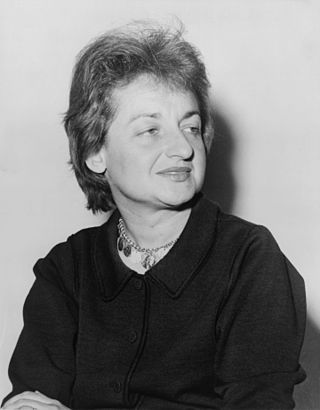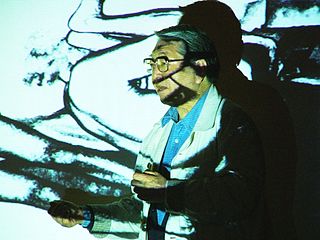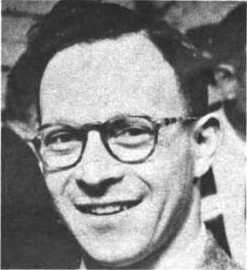
Ansel Easton Adams was an American landscape photographer and environmentalist known for his black-and-white images of the American West. He helped found Group f/64, an association of photographers advocating "pure" photography which favored sharp focus and the use of the full tonal range of a photograph. He and Fred Archer developed a system of image-making called the Zone System, a method of achieving a desired final print through a technical understanding of how the tonal range of an image is the result of choices made in exposure, negative development, and printing.

Betty Friedan was an American feminist writer and activist. A leading figure in the women's movement in the United States, her 1963 book The Feminine Mystique is often credited with sparking the second wave of American feminism in the 20th century. In 1966, Friedan co-founded and was elected the first president of the National Organization for Women (NOW), which aimed to bring women "into the mainstream of American society now [in] fully equal partnership with men".
Robert Frank was a Swiss photographer and documentary filmmaker, who became an American binational. His most notable work, the 1958 book titled The Americans, earned Frank comparisons to a modern-day de Tocqueville for his fresh and nuanced outsider's view of American society. Critic Sean O'Hagan, writing in The Guardian in 2014, said The Americans "changed the nature of photography, what it could say and how it could say it. [ ... ] it remains perhaps the most influential photography book of the 20th century." Frank later expanded into film and video and experimented with manipulating photographs and photomontage.

Color photography is photography that uses media capable of capturing and reproducing colors. By contrast, black-and-white or gray-monochrome photography records only a single channel of luminance (brightness) and uses media capable only of showing shades of gray.

Eve Arnold, OBE (honorary), FRPS (honorary) was an American photojournalist, long-resident in the UK. She joined Magnum Photos agency in 1951, and became a full member in 1957. She was the first woman to join the agency.

Eikoh Hosoe is a Japanese photographer and filmmaker who emerged in the experimental arts movement of post-World War II Japan. Hosoe is best known for his dark, high contrast, black and white photographs of human bodies. His images are often psychologically charged, exploring subjects such as death, erotic obsession, and irrationality. Some of his photographs reference religion, philosophy and mythology, while others are nearly abstract, such as Man and Woman # 24, from 1960. He was professionally and personally affiliated with the writer Yukio Mishima and experimental artists of the 1960s such as the dancer Tatsumi Hijikata, though his work extends to a diversity of subjects. His photography is not only notable for its artistic influence but for its wider contribution to the reputations of his subjects.

Danny Lyon is an American photographer and filmmaker.
Irving Penn was an American photographer known for his fashion photography, portraits, and still lifes. Penn's career included work at Vogue magazine, and independent advertising work for clients including Issey Miyake and Clinique. His work has been exhibited internationally and continues to inform the art of photography.

Arnold Abner Newman was an American photographer, noted for his "environmental portraits" of artists and politicians. He was also known for his carefully composed abstract still life images.

William Klein was an American-born French photographer and filmmaker noted for his ironic approach to both media and his extensive use of unusual photographic techniques in the context of photojournalism and fashion photography. He was ranked 25th on Professional Photographer's list of 100 most influential photographers.

Charles O'Rear is an American photographer. His image Bliss was used as the default desktop wallpaper of Microsoft's Windows XP operating system. O'Rear started his career with the daily newspapers Emporia Gazette, The Kansas City Star, and Los Angeles Times; worked for National Geographic magazine; and was part of the Environmental Protection Agency's DOCUMERICA project. He began photographing winemaking in 1978.

Documerica was a program sponsored by the United States Environmental Protection Agency to "photographically document subjects of environmental concern" in the United States from about 1972 to 1977. The collection, now at the National Archives, contains over 22,000 photographs, more than 15,000 of which are available online. The title is a portmanteau of "documentary" and "America".
Arthur Leipzig was an American photographer who specialized in street photography and was known for his photographs of New York City.

Ed Feingersh (1925–1961) studied photography under Alexey Brodovitch at the New School of Social Research. He later worked as a photojournalist for the Pix Publishing agency. His talent for available light photography under seemingly impossible conditions was well recognised. His pictures of Marilyn Monroe are his best known, but he was a prolific photojournalist throughout the 1950s. Two of his moody photographs of jazz performers were selected by Edward Steichen for MoMA’s world-touring The Family of Man exhibition.
Suzanne Szasz was a Hungarian-born American photographer of children and family life.
Bradley Smith was an American magazine photographer, writer, photojournalist and a founder of the American Society of Magazine Photographers.
Ewing Krainin was an American magazine, advertising and travel photographer active 1940s-1970s.
Ralph M. Hattersley, Jr. (1921-2000) was an American photographic educator, commentator, journalist and photographer.

Arthur Lavine was an American mid-century photojournalist and magazine photographer who, among other achievements, produced significant documentation of New Caledonia during World War 2.
Sam Falk was an early- and mid-twentieth-century American photojournalist who worked for The New York Times from 1925 to 1969, and wrote and photographed for other publications.












